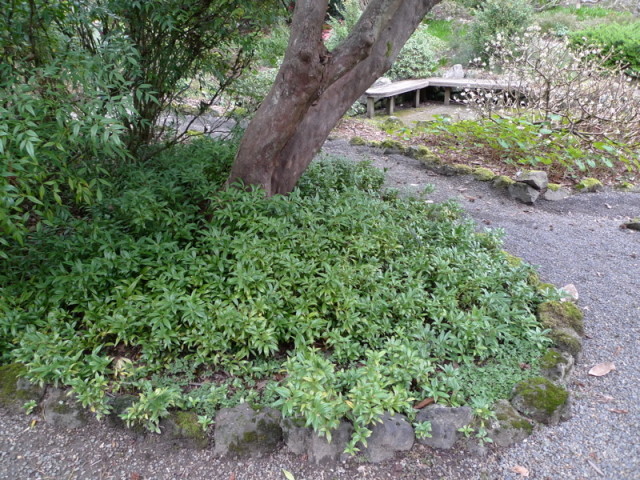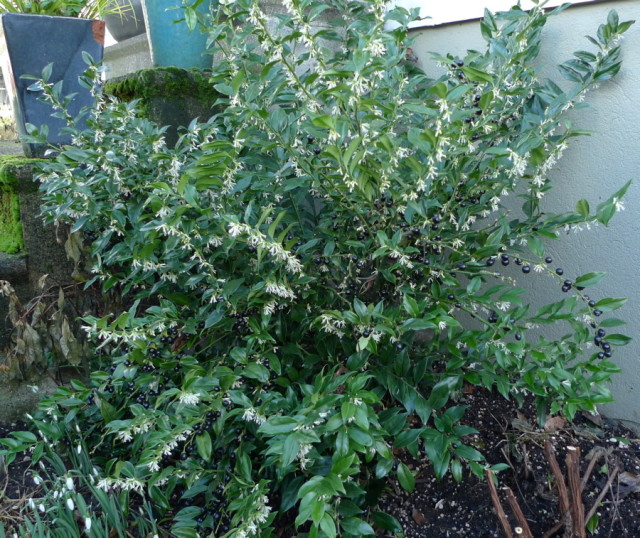Sweet box

Himalayan box (Sarcococca hookieriana var humilis growing around the base of a tree at the Bishops Close in Portland’s Dunthorpe neighborhood. This photo was taken in March last year so the flowers are pretty much done and perhaps the foliage looks a bit worse for wear after the frigid temperatures it had just gone through… it’s much greener this year!
Gosh, I’m predicable: I enthuse about sweet box (Sarcococca sp.) every January and February. Also known as Christmas box and Himalayan box, these demure shrubs possess the sweetest scent around and you don’t even have to crouch down in the cold mud and plunge your nose deep into the wet foliage to smell it – no, just stroll around within 20 feet downwind of it and it will be unmistakable. It’s that powerful, that delicious, and that enchanting.
The softly sweet, vanilla fragrance is the primary reason to grow it. But it also happens to be a pretty little thing, with glossy, dark green evergreen foliage and tiny, thread-like creamy white flowers which turn into small red or black fruit in summer.
Perhaps best of all, Sarcococca are also adaptable and tough plants. Given reasonably rich, well-drained, acidic soil and shade or dappled sunlight, they are quite tolerant of our dry summers, although they flower best if they receive some supplemental water in late summer, when they are forming the following year’s flower buds. Like most rhododendrons and camellias, they can take direct morning sun if they receive a bit of summertime water but keep them out of dry spots in direct, hot afternoon sun – that’s what rosemary, Santolina and Cistus are for!

Sarcococca confusa in flower, late January
Like their close relative, boxwood, Sarcococca are not bothered by deer. But what’s especially nice about Sarcococca is that they are tough enough to withstand the often-difficult conditions found near the foundations of houses. For instance, they can take some root competition from other plants once established, and often grow remarkably well in those marginal areas around the eaves. (They cannot grow directly under one of those giant, overhanging, Craftsman-style eaves, though – not much can!)
There are several species of Sarcococca that do well in the Pacific Northwest: three common types – all exquisitely fragrant – and a bunch that are less common and require a little poking around to find.
Sarcococca hookieriana var. humilis is a low-growing, politely suckering plant that can spread widely over time making a 1 to 2-foot tall evergreen ground cover for a shady spot. It’s great as a ground-cover and an understory beneath rhododendrons, camellias,
Sarcococca ruscifolia is a 4-5-foot tall (and about as wide) species with small black fruit that turn red in late summer when ripe.
Sarcococca confusa – also a 3-5 foot tall (and about as wide) species but with black fruit.
A little harder to find but worth the search:
Sarcococca hookeriana var. digyna – said to be "the best form of Christmas box" by Xera Plants (and much-touted in classic English gardening books), it has purplish-red stems and larger flowers than the fairly commonplace S. hookeriana var. humilis.
Sarcococca orientalis – possessing the largest and perhaps most fragrant flowers of the winter boxes, this 3-foot tall and wide species flowers from December to March. The leaves are a bit chunkier and wider than most other species.
Sarcococca saligna – a little less cold-hardy than the other species, this species has slender, lighter green leaves and clusters of sweetly fragrant green flowers that appear in the autumn from October to mid-winter. Plants reach about 3 feet tall and wide and have a more delicate, willowy, arching form than any of the other species mentioned here. I snuck this one in – it’s really more of a fall-blooming plant than a winter-bloomer but heck, it’s still darling.
Sources:
Xera Plants – a wholesale-only outfit whose plants can be found at most of our wonderful local retailers including Garden Fever Nursery, Dennis’ Seven Dees Nursery and the Portland Nursery
